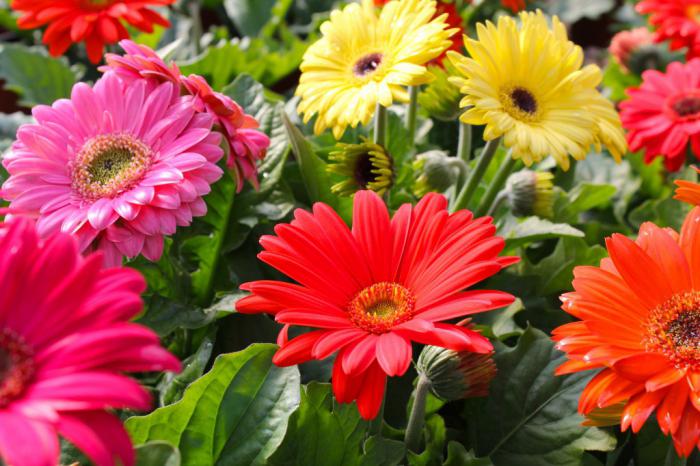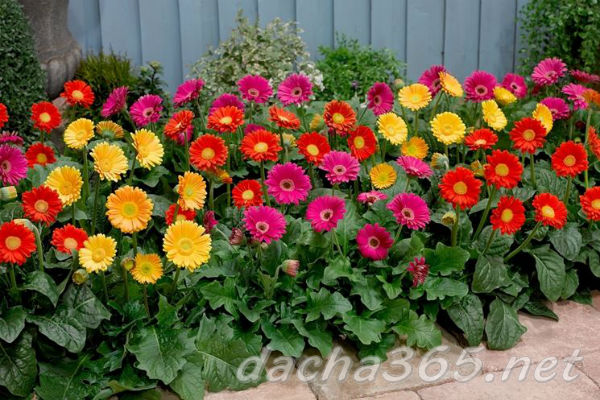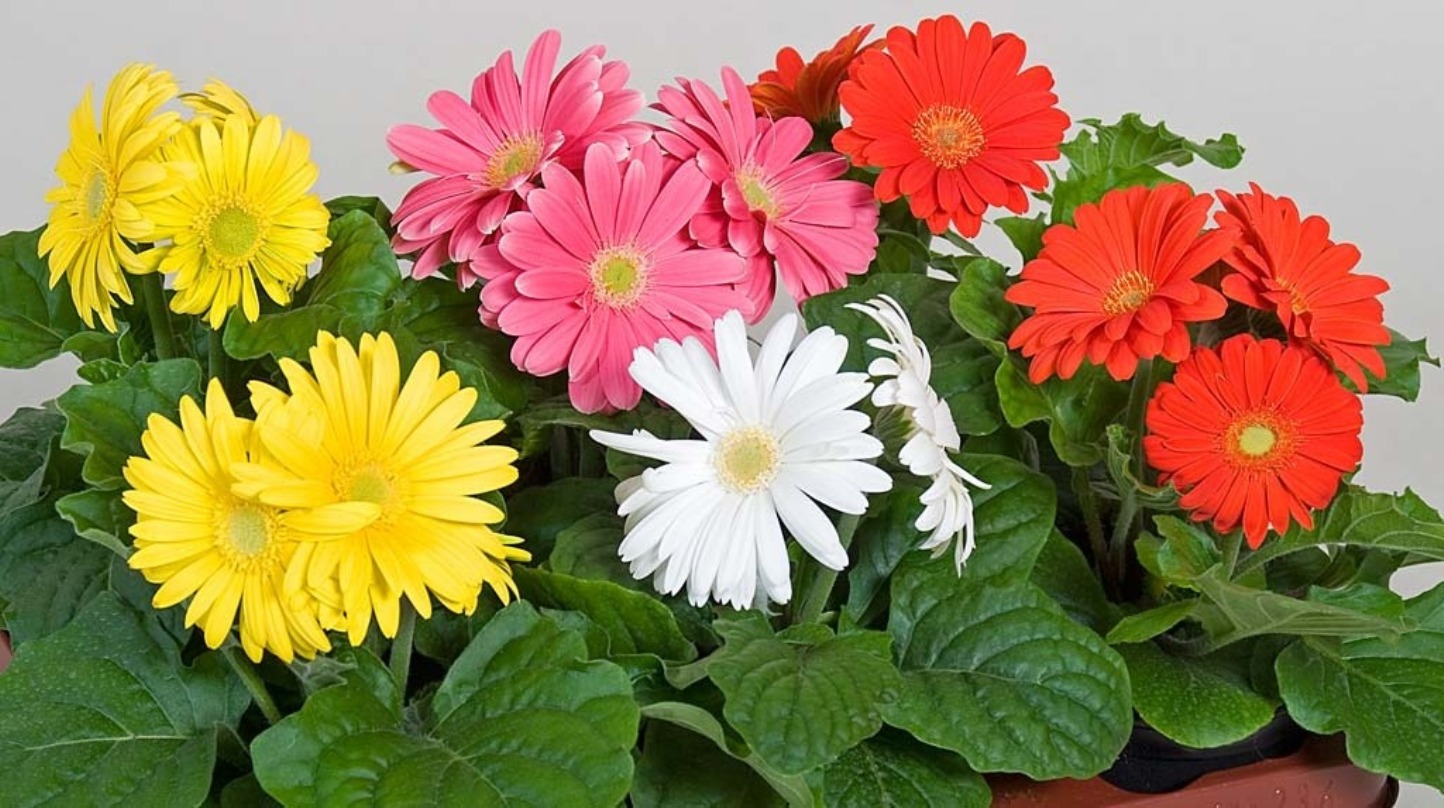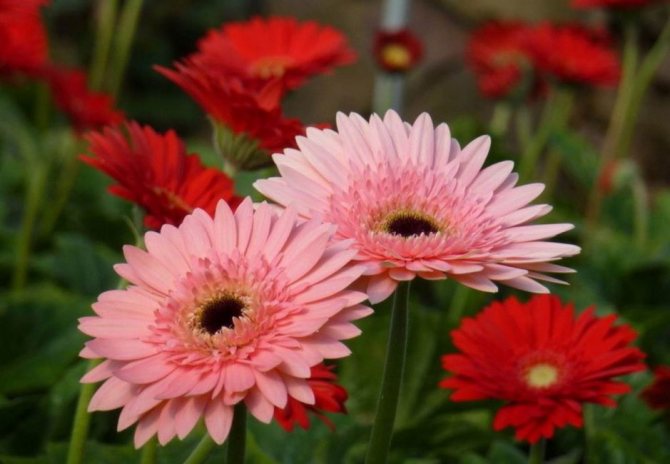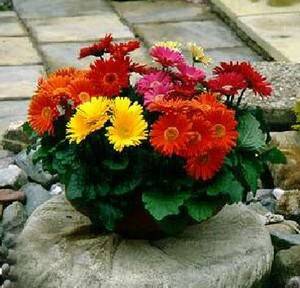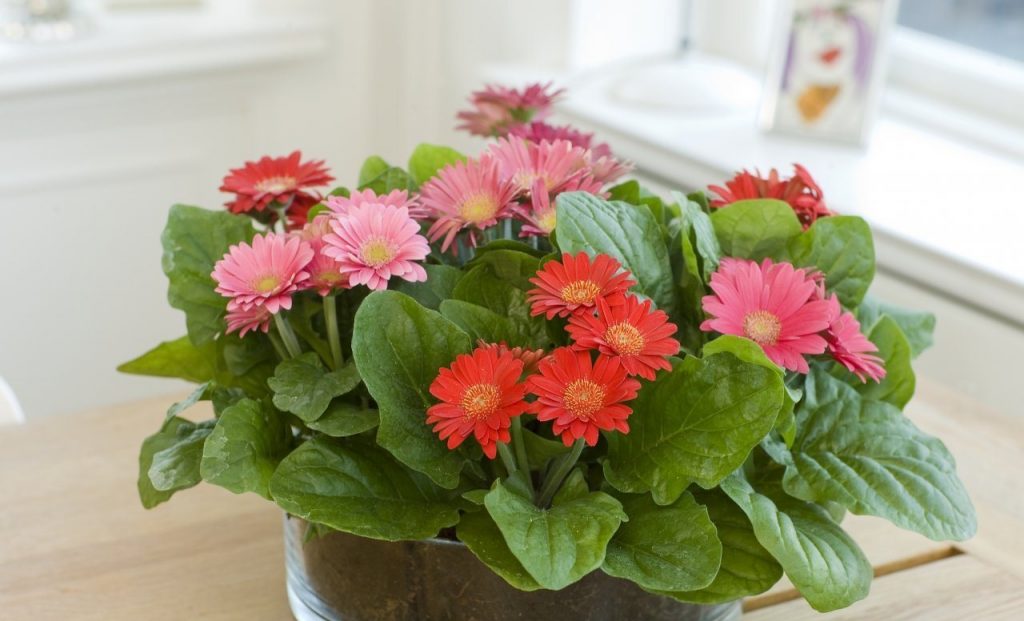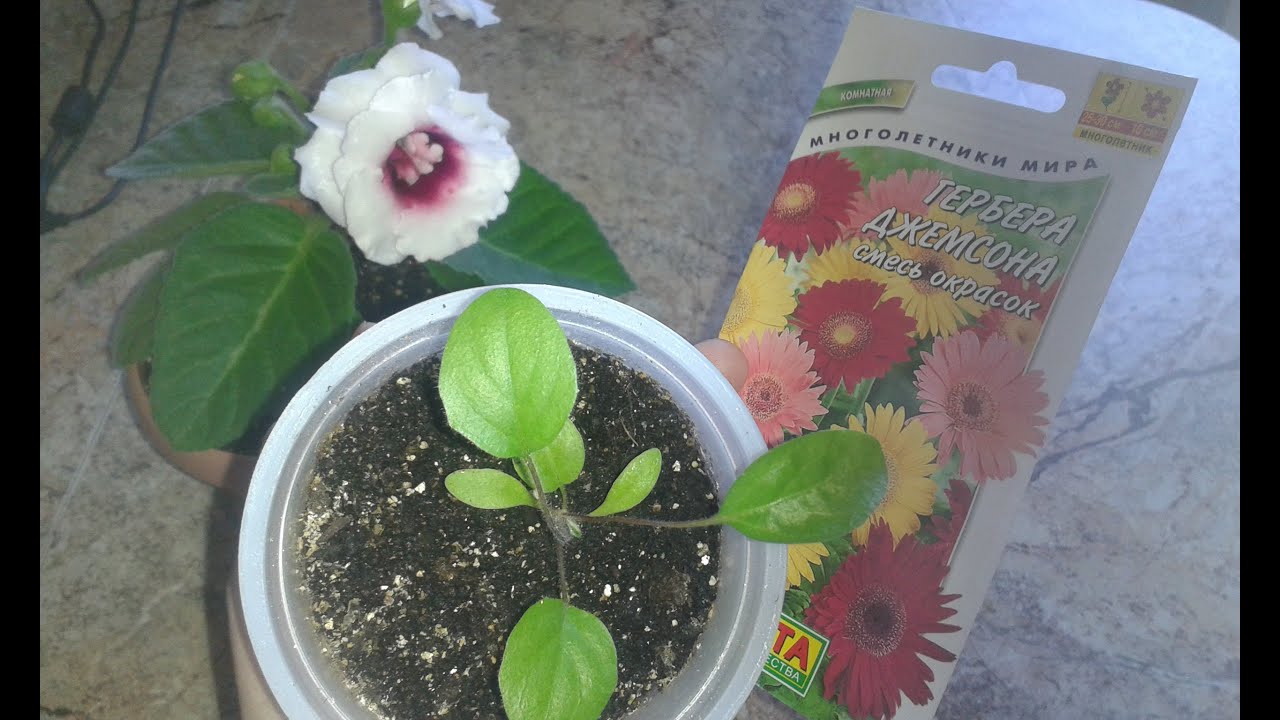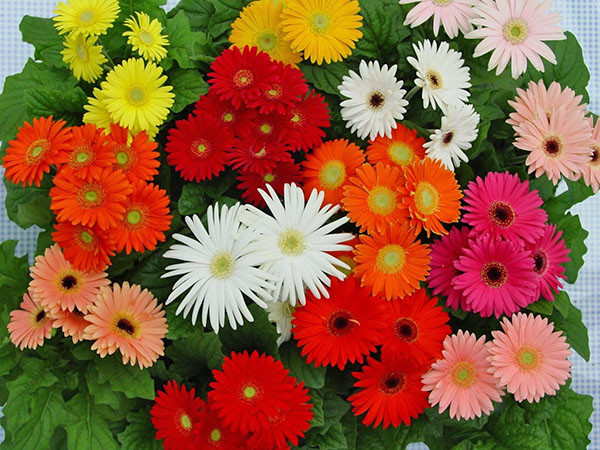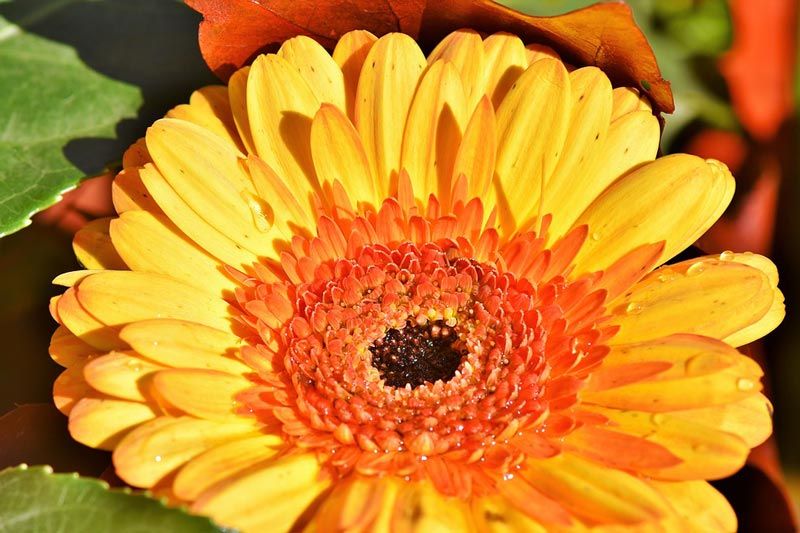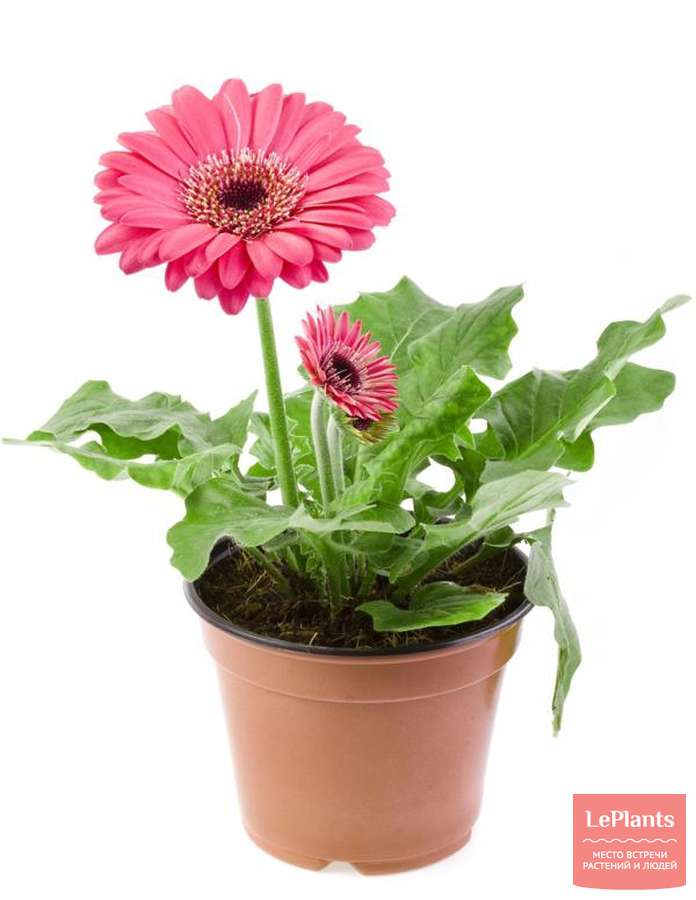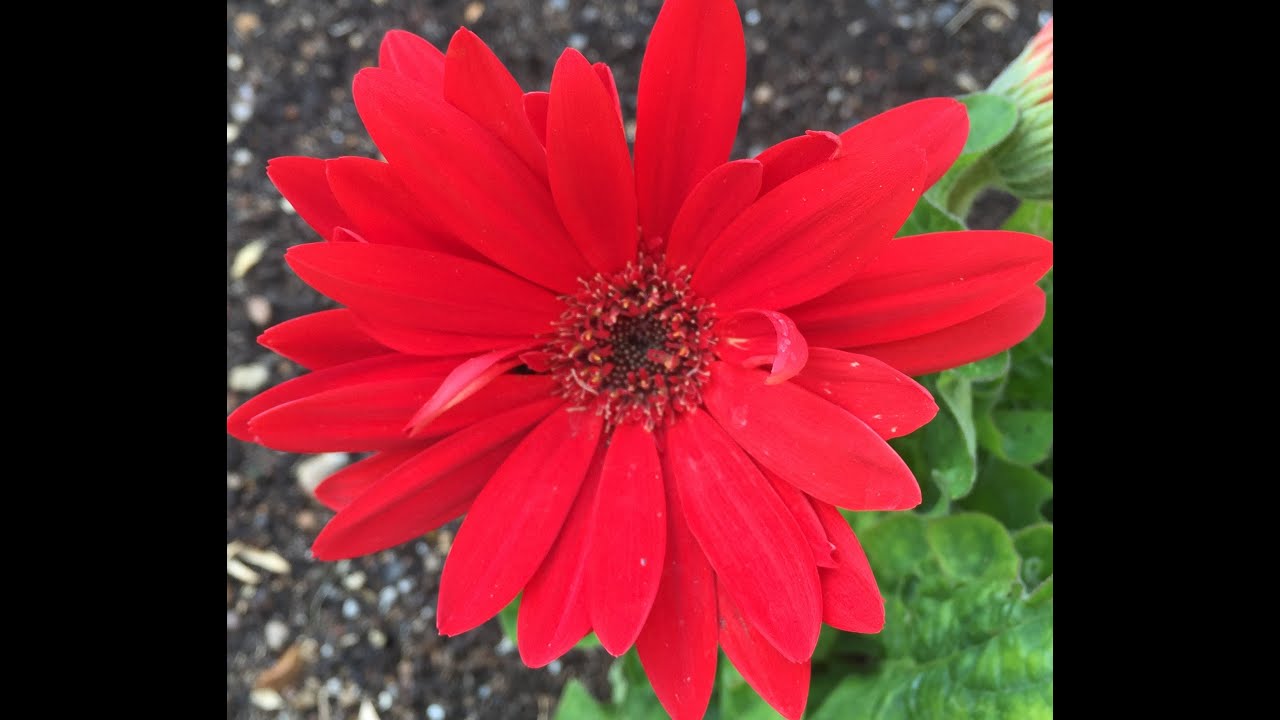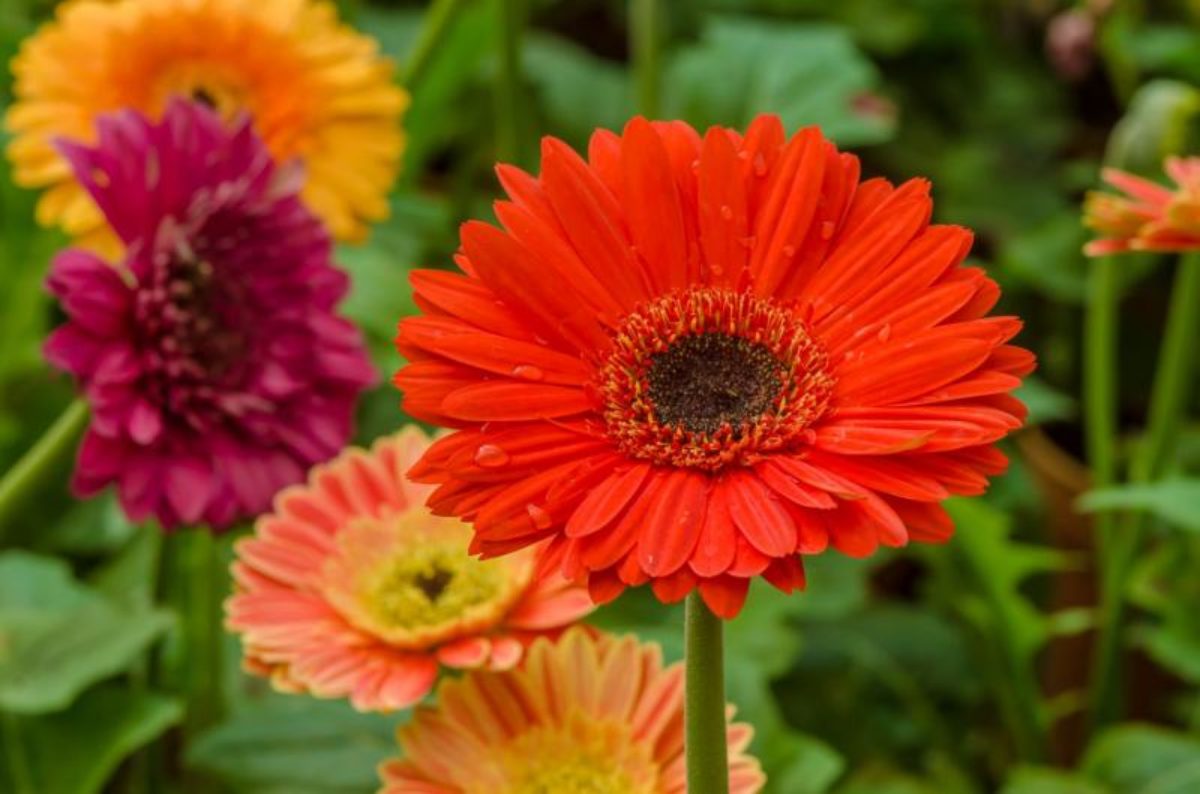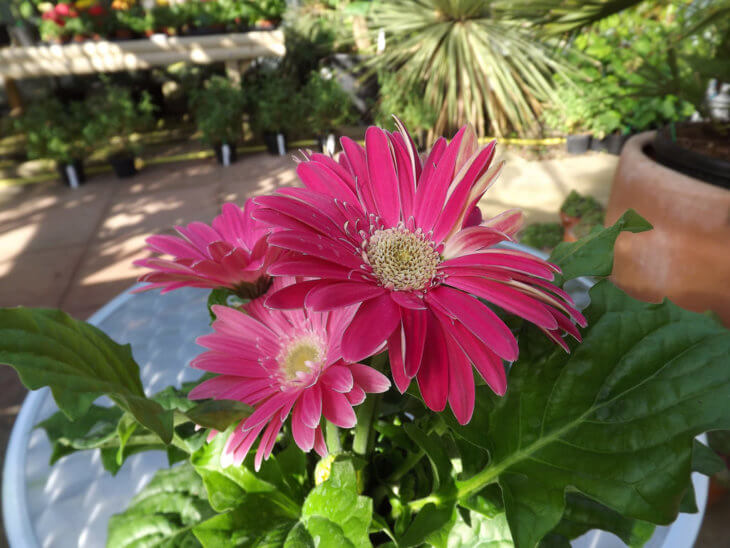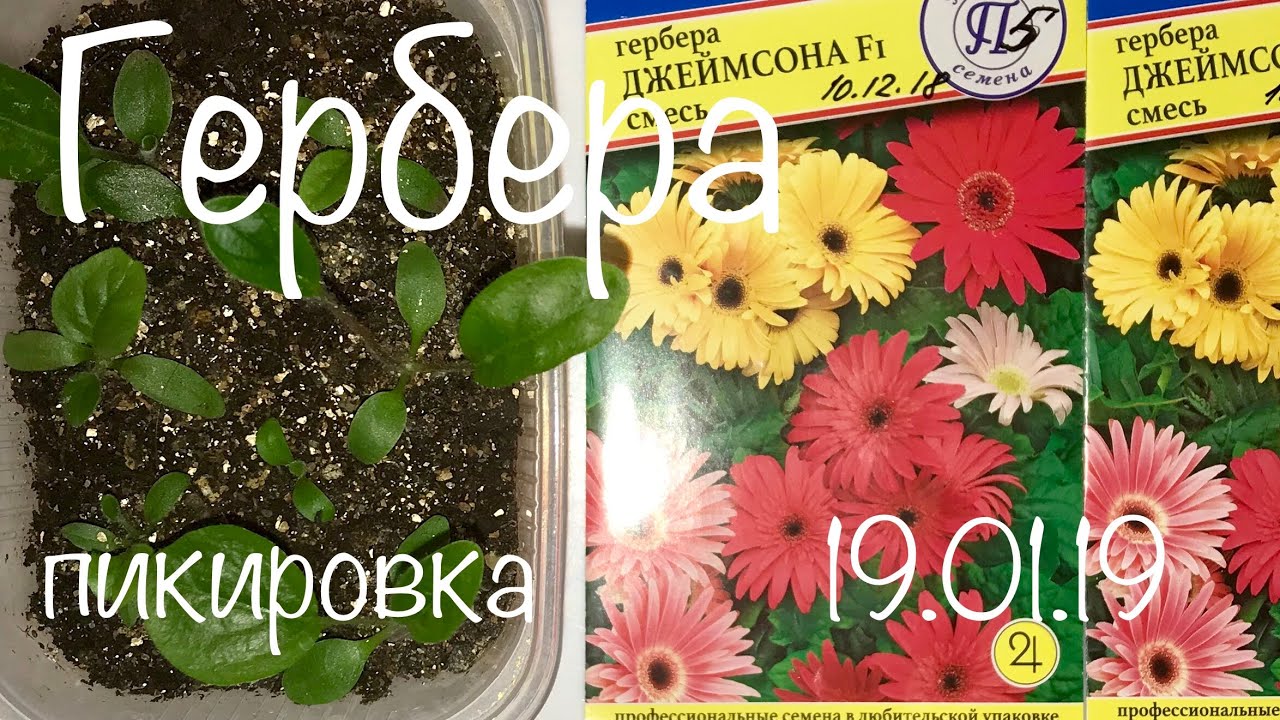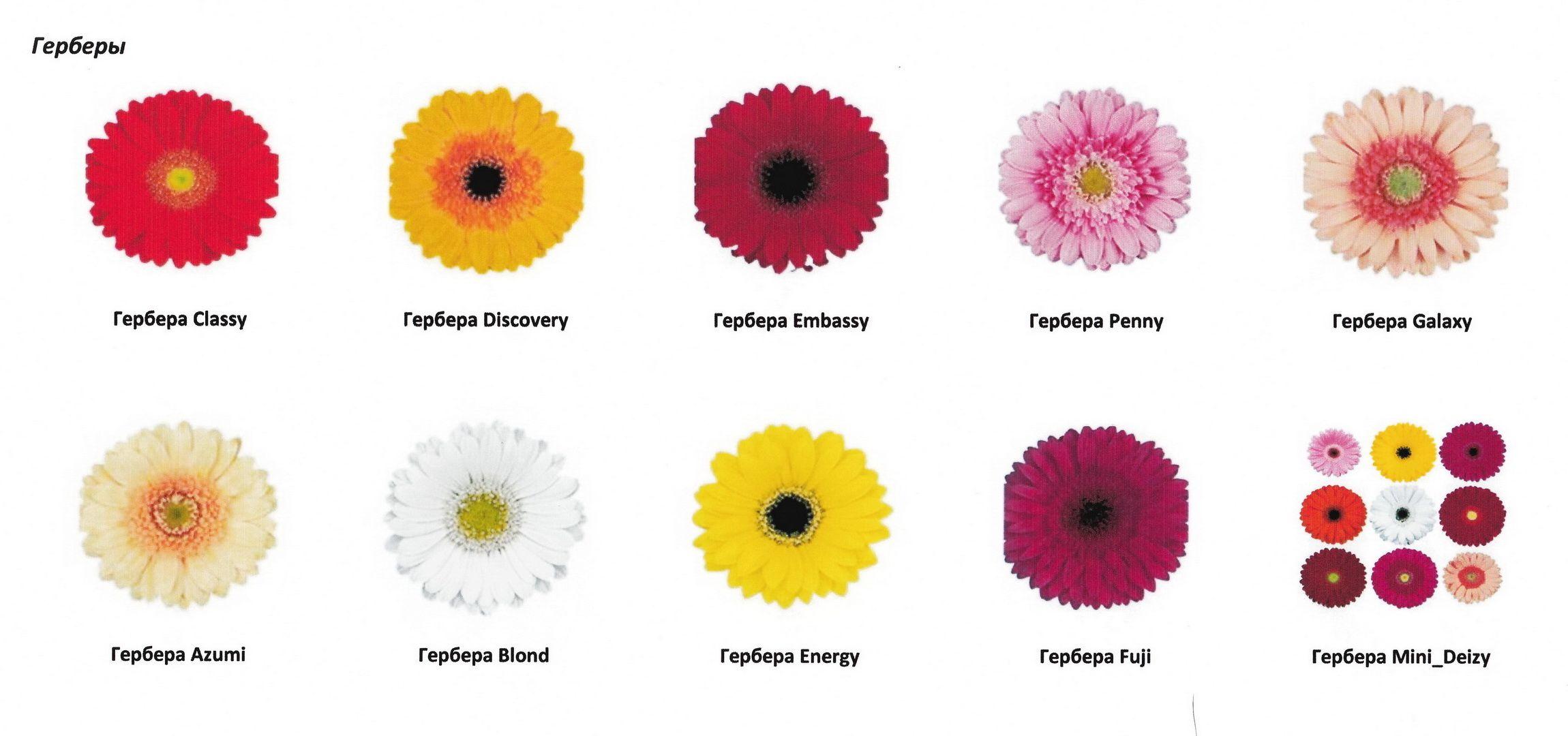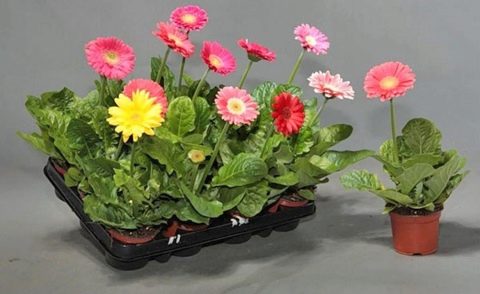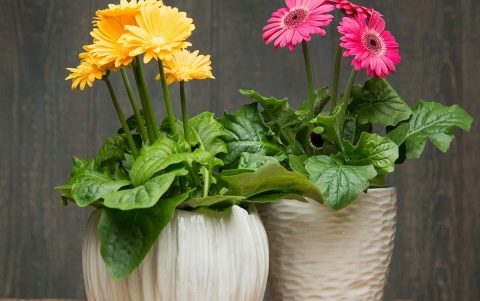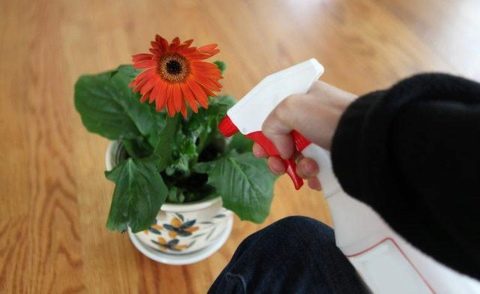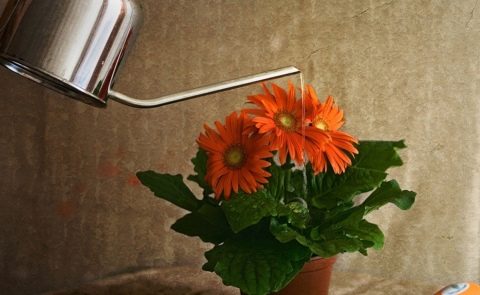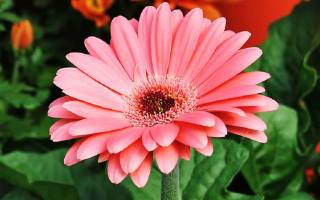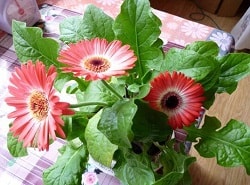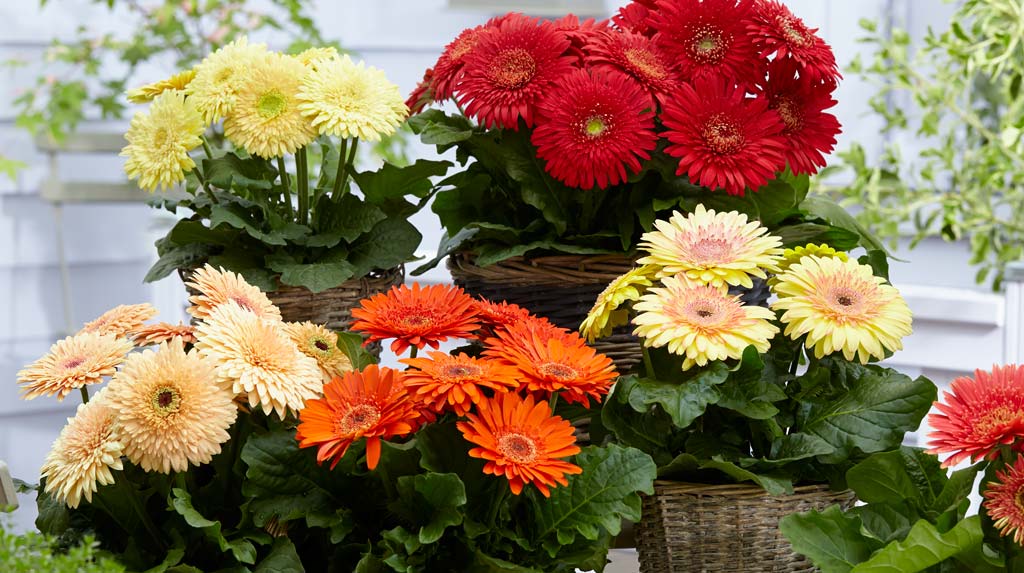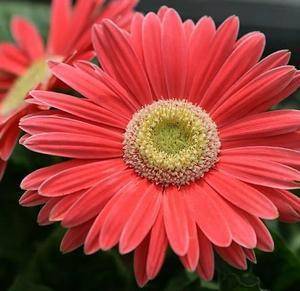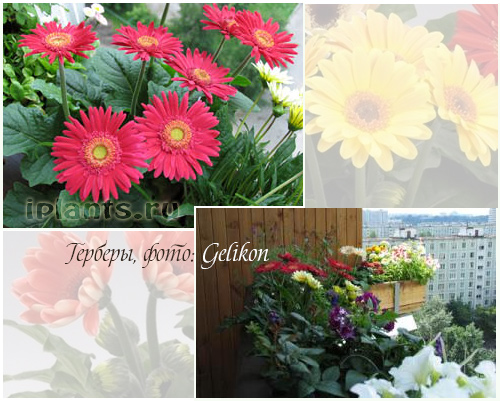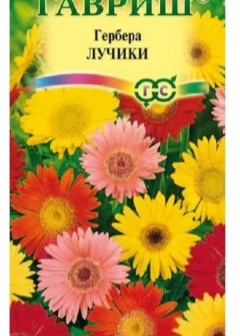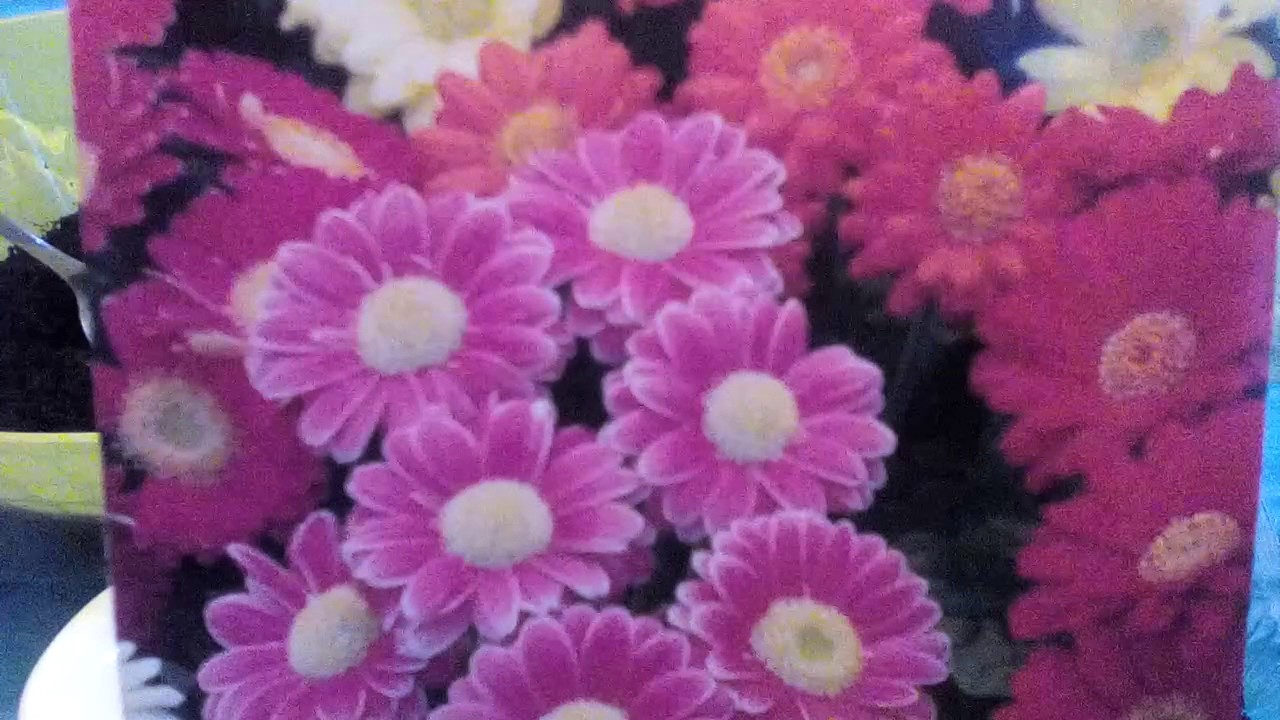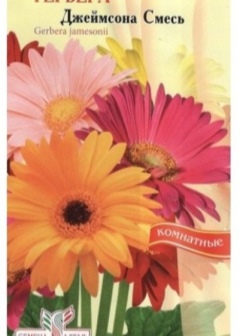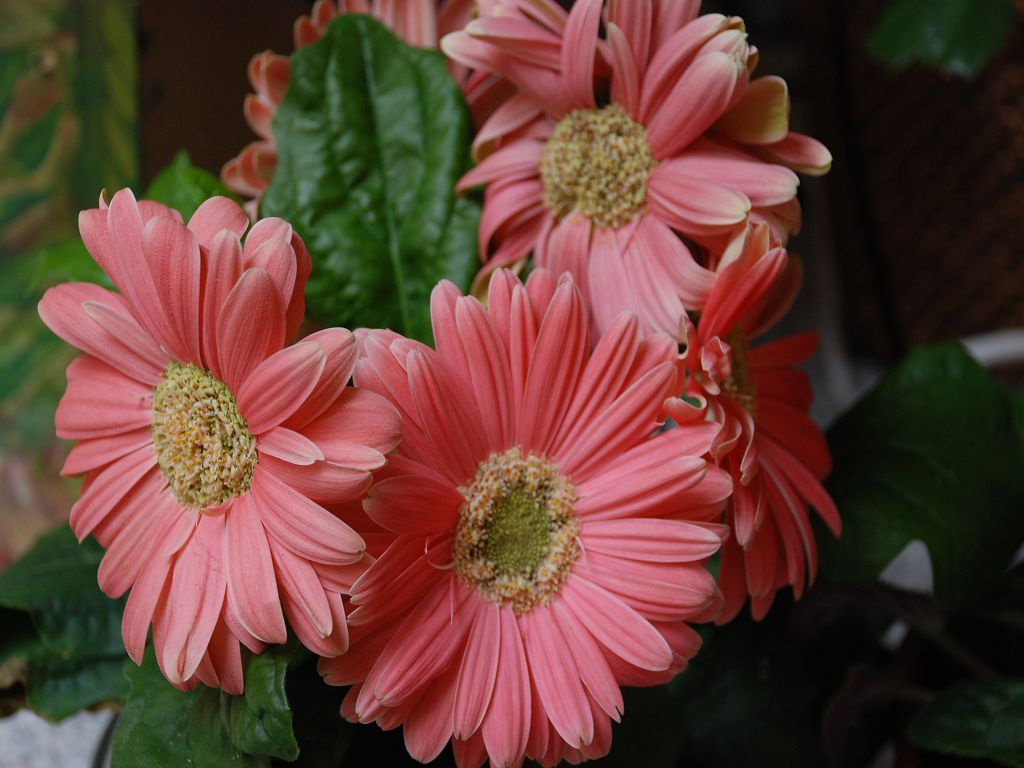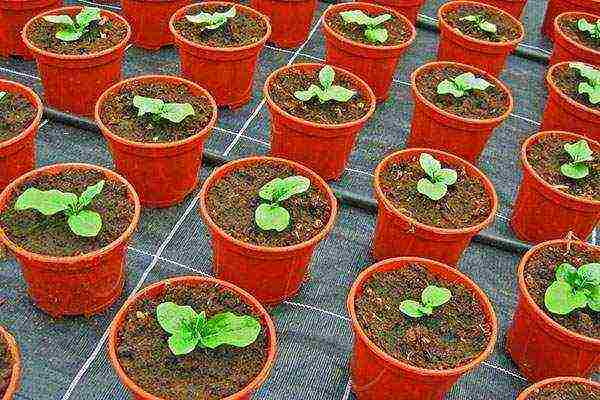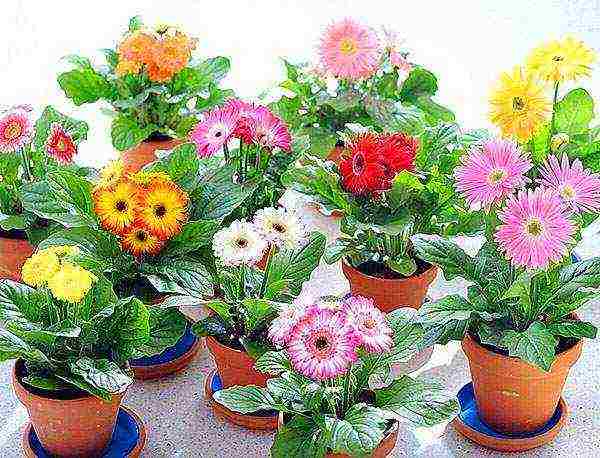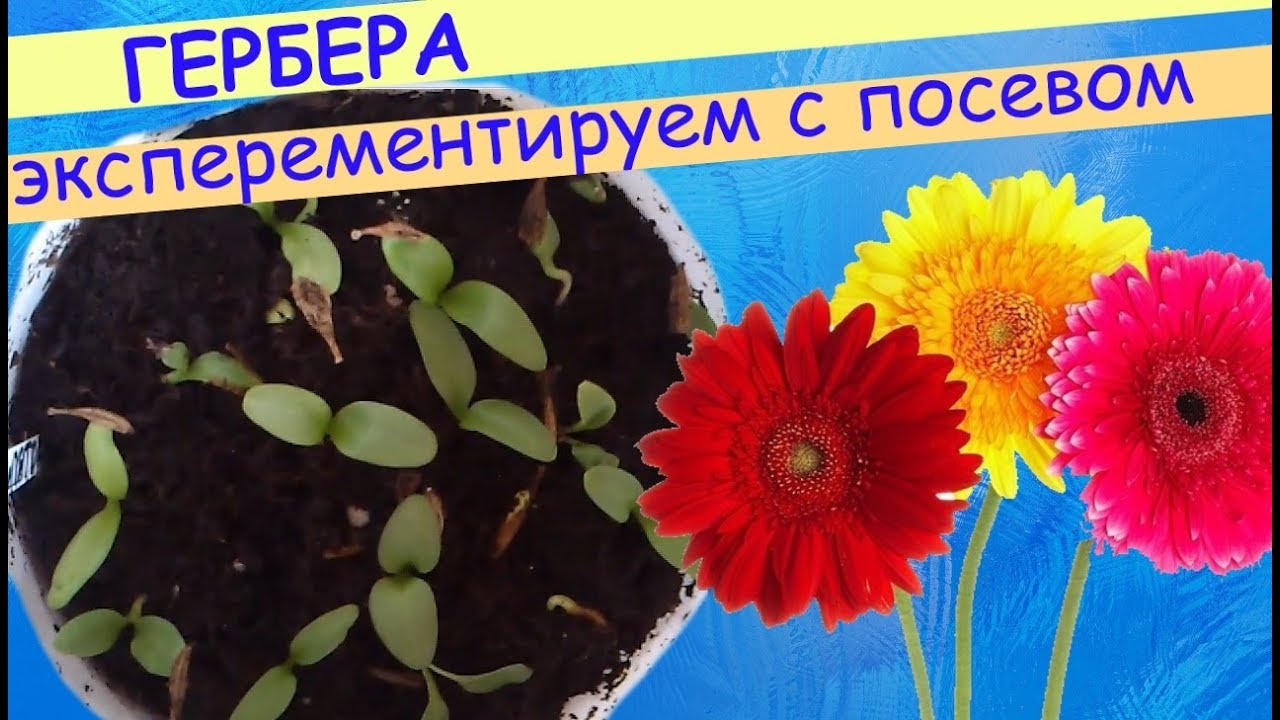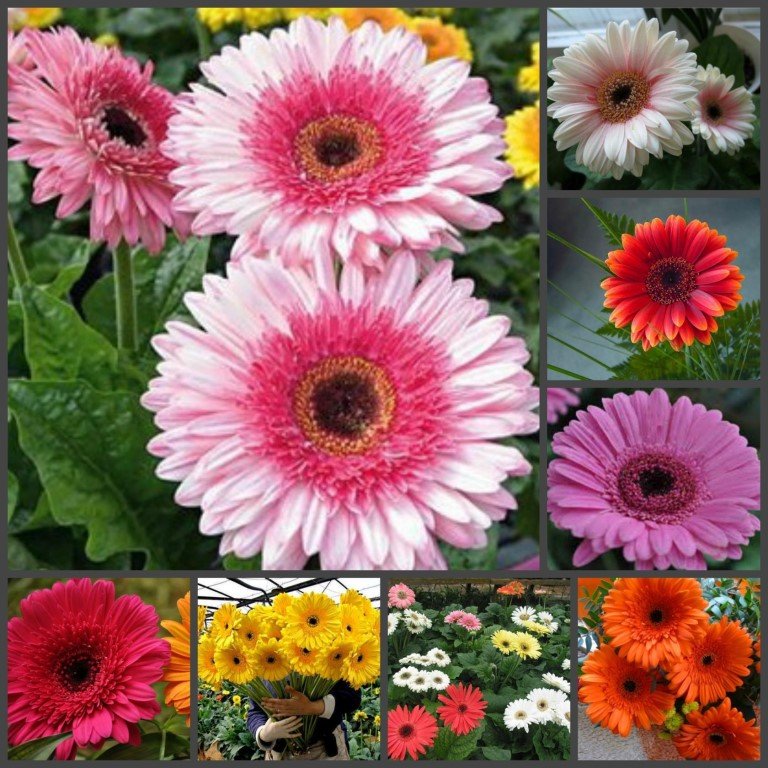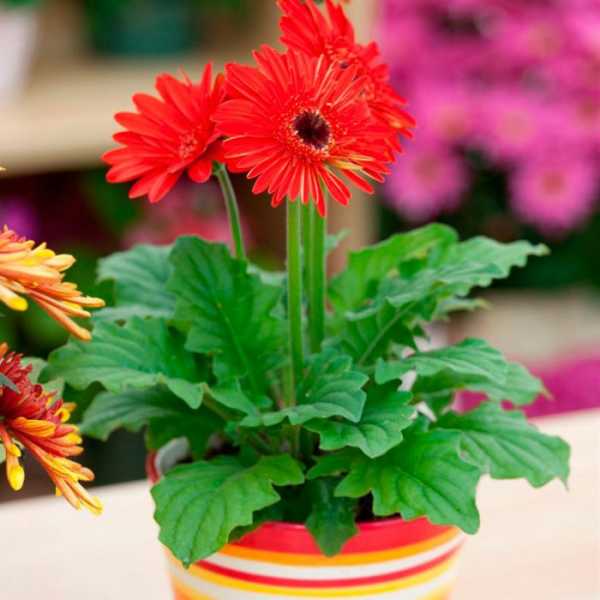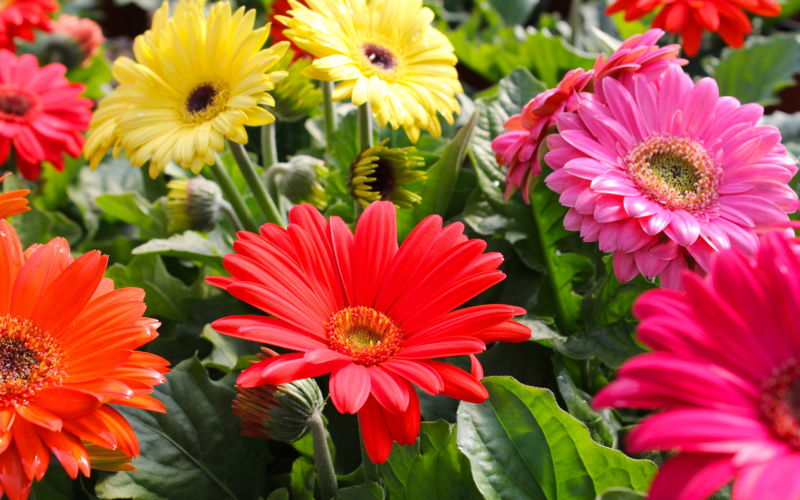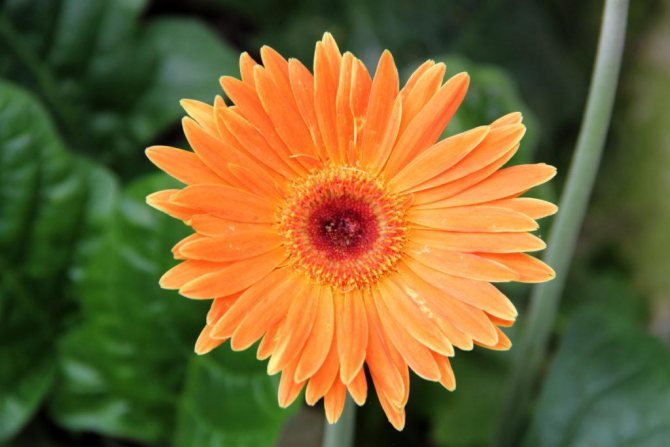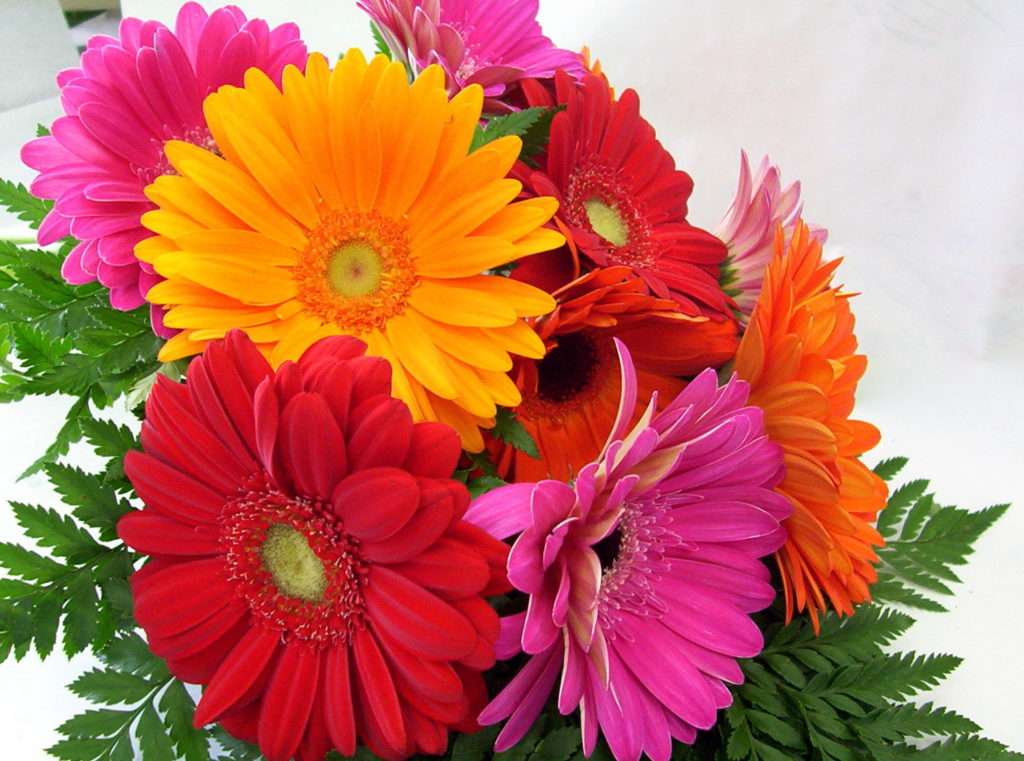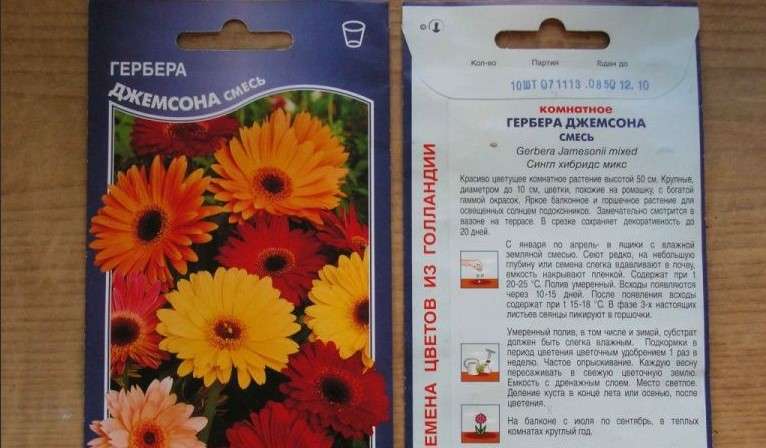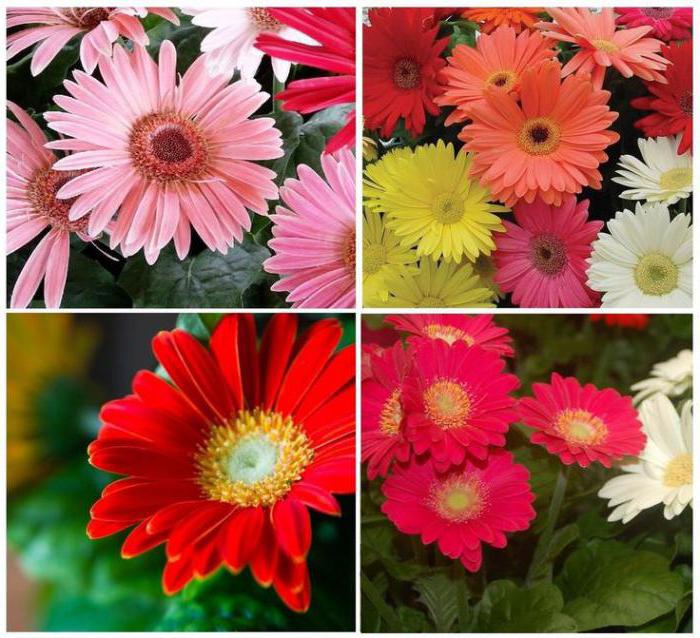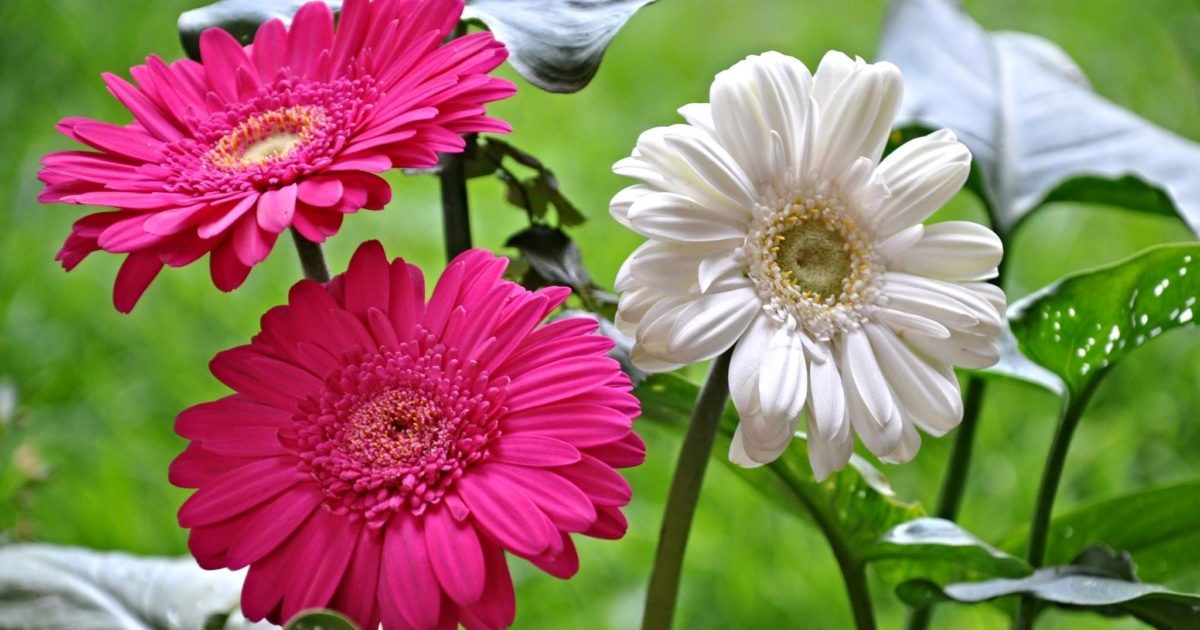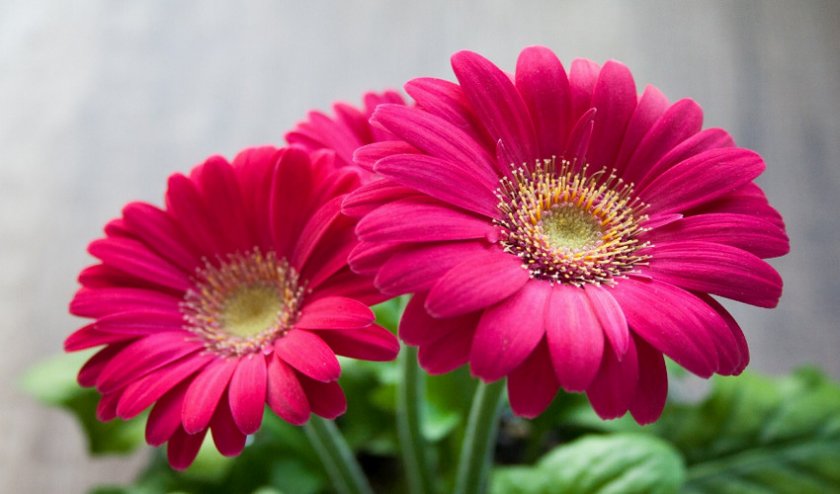Reproduction of gerbera at home
Gerbera willingly reproduces in "captivity" in several ways. Let's consider them in order.
By dividing the bush
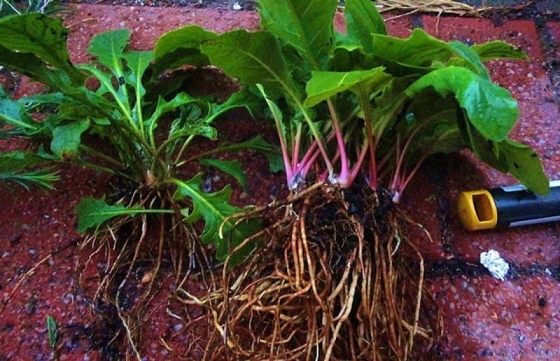
This is the easiest way to get a new gerbera bush from a healthy plant at the age of 3-4 years, on which several basal rosettes have formed. In the spring, during the transplantation of a flower, it is divided into parts so that each has 2-3 points of growth (at least one) and a part of the root system. The root system should first be soaked for 2-3 hours in warm water, slightly pink from potassium permanganate. After that, the roots should be carefully cleaned of the ground, untwisted, if possible, with your hands. Use a clean knife or scissors to divide the roots. Sprinkle all sections with crushed charcoal (activated) charcoal or cinnamon.
Transplant the bushes obtained during dividing into separate small pots filled with a substrate suitable for adult gerberas, water. Groom in the future as usual. When transplanting, make sure that the growth points are 2-3 cm above the soil surface. Rooting takes a long time, from six months to a year, then flowering can occur only 10-12 months later or the next year after transplanting.
By cuttings
This method is less effective - cuttings often rot. But you can try. Cut off a part of the stem obliquely from the plant, about 10 cm in length, with 2-3 leaves. It is possible to root the cutting in sand, in perlite or vermiculite, covering the container on top with a plastic bag or glass beaker (jar), maintaining high humidity, a temperature of 25-27 ° C and, if possible, bottom heating. When a new leaf appears on the handle, we can assume that rooting was successful. Now the cutting can be transplanted into a pot with suitable soil and taken care of like an adult plant.
Growing from seeds

Growing gerberas at home from seeds is a complex and time-consuming method. Moreover, it does not guarantee the preservation of the main varietal characteristics of the flower, such as dwarfism, doubleness of petals, their shades and other "highlights" of the variety. However, the seeds can be harvested by yourself or purchased from the store. Good germination (more than 50%) remains in seeds for six months. If the seeds are more than eight months old, there is no point in planting them. Gerbera specimens grown from seeds will bloom only after two years.
The optimal time for sowing seeds is from the end of January to March. Seeds are sown in containers or other containers from which it will be possible to build a greenhouse. Use a mixture of sand and peat chips as a substrate, which must be well moistened before planting.
- Spread the seeds over the surface, without deepening them, sprinkle on top with a thin layer of fine sand.
- Close the lid of the container (cover the container with glass or foil). Keep in a dark, warm place until germination. Ventilate daily to remove condensation. After 8-10 days, the first shoots will begin to appear.
- Now move the greenhouse to a bright place at a temperature of 18-20 gr. Protect from direct sunlight.
- When the second true leaves appear on the seedlings, it should be cut into small plastic cups (drainage holes and a drainage layer are required!), And into the same substrate. Try to harm the roots as little as possible.
- When young gerberas have 4–5 leaves, they should be transplanted into pots, 9 cm in diameter, in a substrate suitable for adult gerberas. Next, look after as usual.
Reproduction methods
New copies of gerberas can be obtained in 3 ways:
- Seeds. We will talk about this in more detail below. A flower grown in this way will bloom for the first time only after almost a year. For cultivation, you can use seeds collected with your own hands.
- Cuttings. Cuttings are used to preserve the characteristics of hybrid varieties when seed propagation is not suitable. To do this, cut off a part of the stem with a knot and a leaf, and then root it in the ground.
- By dividing the rhizome. To do this, take out an adult plant from the ground and divide the roots. This method, as well as cuttings, helps to obtain a varietal plant similar in characteristics.
Read in detail about all methods of gerbera reproduction in our material.
Gerbera seeds are elongated with a fluffy tassel at the end. The size is small, one gram contains from 300 to 500 pieces.
Pollination of an indoor flower
Gerbera is not a self-pollinated plant, as its reproductive organs ripen at different times. Therefore, to obtain seeds, artificial cross-pollination is required during the flowering period.
Ripe pollen can be used within 100 days. You can store it in a clean, dry glass container with a lid. Both plants must be of the same species to maintain a variety. If this is not possible, you can use what is available.
In this case, the result is unpredictable, the resulting seeds can give a completely different plant in terms of characteristics. For home pollination, ripe pollen from one flower is transferred to another flower.
You can simply collect the pollen with a brush and "smear" the middle of another flower. It is better to do this several times during flowering, to be sure. Ripe pollen can be seen by the protrusion of the middle of the flower with yellowing.
When do they ripen?
The gerbera seed ripens 3-4 weeks after successful pollination. Accordingly, this happens in the fall, at the end of flowering (you can find out about when and how much gerberas bloom and why they do not do this).
How to collect?
Once the middle of the flower becomes fluffy like a dandelion, you can collect the seeds by carefully disassembling the flower with your hands. Gerbera seeds quickly lose their germination, so they need to be planted within 6 months after harvest.
How much are?
Having looked through a bunch of offers on the Internet for the sale of seeds, I can voice the approximate price range for gerbera seeds from 22 to 89 rubles per package, which contains 10-25 seeds. Varieties: Jameson's gerbera, Festival, Rayons, California Giant. The seeds are mostly in the form of mixtures, that is, what color palette you get is unknown.
Below you can see photos of the gerbera and its seeds.
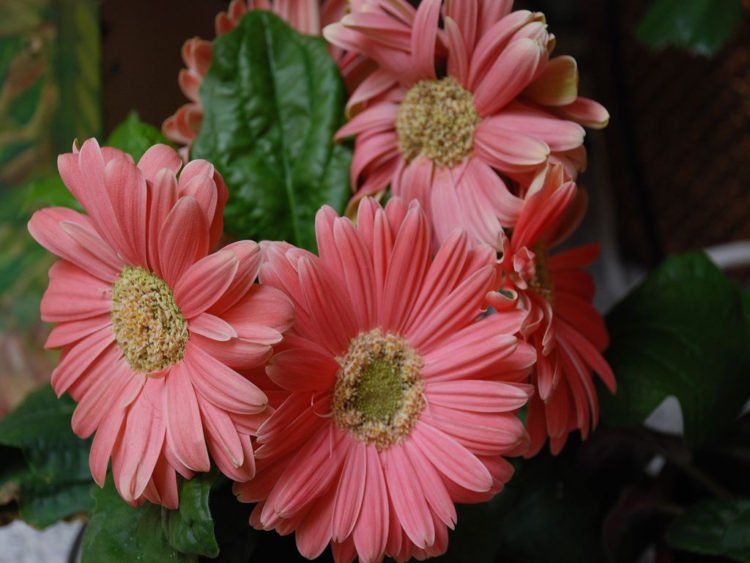

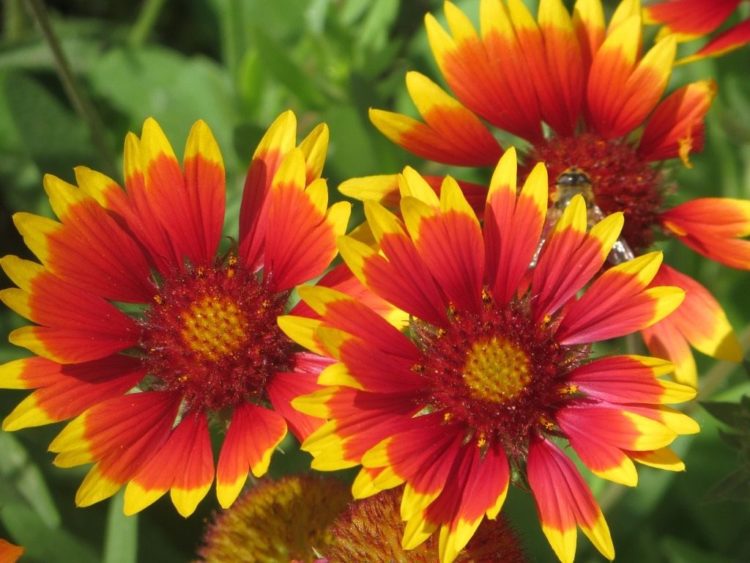
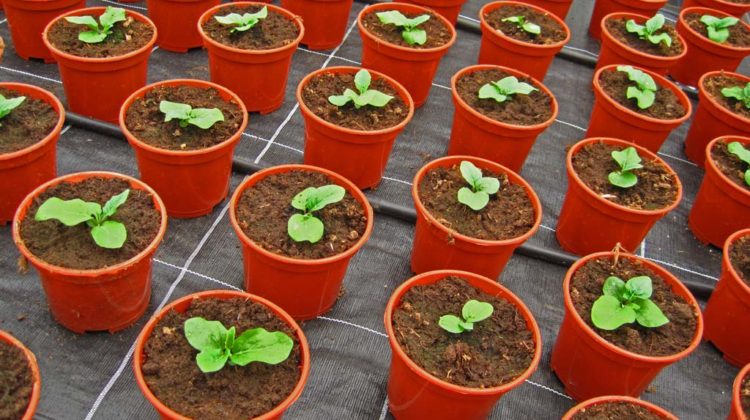

Care
This flower is considered capricious and demanding. You need to know how to grow it and take care of it.
Growing seedlings from seeds
To grow seedlings, you need to buy seeds in the store. Before buying, be sure to check the expiration date, their quality after they have been collected is maintained for 7 months. The planting procedure is carried out in early autumn. Experienced growers grow seedlings in this way all year round.
Seeds are scattered into a container with prepared soil, sprinkling them with the same soil, then watered well. It is recommended to cover the top with plastic wrap.
We recommend watching a video about growing gerbera seedlings from seeds:
Humidity and watering
Future seedlings should be regularly ventilated and sprayed with water. Do not allow the soil to dry out. The first shoots may appear after a few weeks. As soon as three leaves appear, the seedling can be planted in open ground. If he is accepted there, it means that all the rules were followed during the transplant. But in order for the gerbera to have buds and bloom, it is necessary to carry out good watering. Water is taken in a settled, soft, room temperature.
Important: During watering, it is impossible for it to fall on the outlet or leaves. This can lead to decay of the root system.
After the flower blooms, you need to water less.
Temperature and lighting
Even a slight hypothermia turns out to be fatal for a gerbera. The best temperature is considered to be above 10 degrees. It is necessary to grow seedlings from seeds in diffused moderate lighting, if it is good, then in the future the flower will bloom beautifully. Therefore, he needs to be planted in a place that is heated by the sun's rays. The stems of the plant stretch out without proper lighting.
Soil and fertilizers
The seeds are planted in loose, nutrient-rich soil that includes:
- leaf humus;
- peat;
- sand.
You can add a little crushed pine bark there. A drainage layer must be laid on the bottom of the pot. The soil needs to be fertilized. She needs:
- phosphorus;
- potassium;
- magnesium;
- manganese.
Top dressing with appropriate fertilizers is carried out once every two weeks.
Gerberas can be grown and propagated not only in the garden, but also at home, for this we recommend reading the following articles:
- Growing and reproducing a flower at home.
- How to transplant a gerbera after buying at home?
- Detailed instructions for planting and caring for gerberas at home.
- Important rules for caring for potted gerberas.
- Gerbera from seeds at home.
- How to grow a gerbera?
Diseases and pests
The most common gerbera disease is decay of the root collar. This is due to stagnant moisture or as a result of the presence of fungus in the infected soil. It is necessary to properly water and improve drainage.
Excess moisture in the soil leads to the appearance of gray rot, which is destroyed with special means. In very hot weather, gerbera can be affected by powdery mildew. It is fought with the help of preparations containing sulfur, as well as fungicides.
Gerbera can die due to an attack on her:
- spider mite;
- thrips;
- aphids.
Their appearance is evidenced by the yellowing and wilting of the flower. Special insecticidal preparations will come to help in the fight against spruce pests.
Features of care in summer and winter
Summer care consists of:
- systematic watering;
- regular loosening of the soil;
- fertilization;
- protection from pests and diseases.
For the winter, the garden gerbera must be covered; for this, dry leaves or straw are used. In areas that are characterized by a harsh climate, this flower is grown as an annual, or it is dug up together with a clod of earth, and planted in a large pot until spring. They are placed in a room with a temperature of 7-8 ° C, which is well lit and ventilated.
Seed sowing rules
Jamson's gerbera seeds do not need to be prepared. Unlike other flowers, such as Turkish carnations or rhododendrons, they retain the ability to germinate for a very short time - a maximum of eight months, which makes it somewhat difficult to obtain a good result. They are sown for seedlings around the beginning of March, since this flower has a long growing season.
For planting seedlings, medium-sized containers or boxes are used. The seeds are spread on the surface of the moistened soil and covered with a layer of sand, no more than five millimeters thick. Next, moistening is carried out from a sprayer and covered with a transparent film on top. Germination takes place within ten days at a temperature of about twenty-two degrees Celsius, during which the crops are aired daily.
After the emergence of seedlings, the film is removed, and after a while, when the first pair of true leaves is formed, the Jamson gerbera is picked into separate flower pots, leaving the root collar strictly flush with the ground. Ten days after transplanting, the first feeding is performed with universal mineral complexes.
To the main place of growth in the garden, like the related Echinacea officinalis, is transferred at the beginning of summer, since even late frosts can destroy immature plants. Planted in single or group plantings, leaving an interval of about twenty centimeters.
Video. Room gerbera care
Further care of flowers consists of watering and protection from pests. Among the latter are spider mites, aphids and whiteflies. The first can be dealt with by increasing air humidity, and in other cases, insecticides can be used.
In winter, Jameson's gerbera needs a dormant period, and therefore in the fall it is again transplanted into pots and sent to a room with an air temperature of about ten degrees Celsius until spring.
The flowering of Jameson's gerbera when planted in early March will begin only at the end of August and will last until the first frost, and sometimes it blooms only in the second year. Indoors, it will bloom for about four months.
Gerbera seed growing technology
If you have not already purchased an adult plant or just want to experiment, then it is quite possible to grow a gerbera from seeds.
Seed preparation
- Can be purchased ready-made at a garden store. But before buying, be sure to check the expiration date. Gerbera seeds retain their germination capacity for 7 - 8 months.
- If you have at least one adult plant, then you can get the planting material yourself. To do this, you need to pollinate the flower. But the coloration of subsequent specimens may be different from the parent plant. And the germination of home seeds is only 3 months.
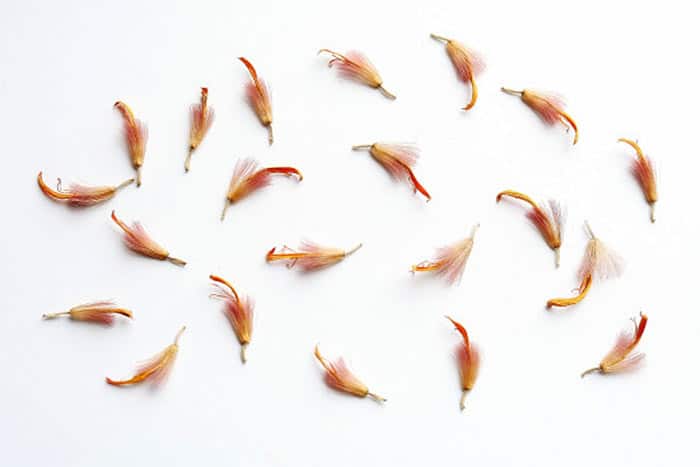
Timing and composition of the soil
Planting can begin in the spring. But different options are allowed. The main thing is to be able to organize additional lighting.
Gerberas can only be grown by seedlings. To do this, you need to prepare your own soil mixture. You will need to mix the following components taken in the same parts:
Alternatively, take equal parts sand and peat. Mix until smooth. The prepared soil mixture must be watered with a solution of potassium permanganate. Then place the substrate in a cool place to freeze. Thus, all harmful and dangerous microorganisms and bacteria will be destroyed.
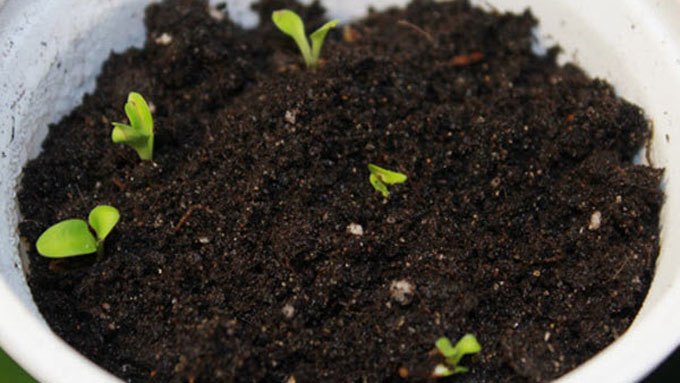
Landing
- Prepare containers for growing seedlings in advance, these can be containers or boxes. At the bottom, you need to make small drainage holes so that air can pass through and moisture does not stagnate.
- Pour a 3 cm thick drainage layer at the bottom. Expanded clay, pieces of foam rubber, pebbles will do.
- Then fill the container with the prepared substrate. It should be tamped down a little.
- Moisten the soil and place the seeds, pressing slightly into the soil. Sprinkle lightly with sand on top.
- Cover the top of the container with foil, plastic or glass.
- The temperature regime must be maintained at +15 - 20 degrees. Several times a day, the shelter must be removed and the planted gerberas must be ventilated.
Dive
Somewhere in a week and a half, shoots will appear. After that, the shelter must be removed. When the first independent leaves appear, the sprouts must be dived into a wide container with an interval of 6 - 8 cm.
When 5 - 6 leaves appear on the stem, the seedlings need to be planted in different pots or plastic cups. The diameter of the containers must be at least 10 cm.
Prepare the soil as follows, mix:
- 1 part river sand;
- 1 part peat;
- 1 part of humus;
- 2 pieces of leafy land;
- 1 piece of turf;
- a small amount of perlite.
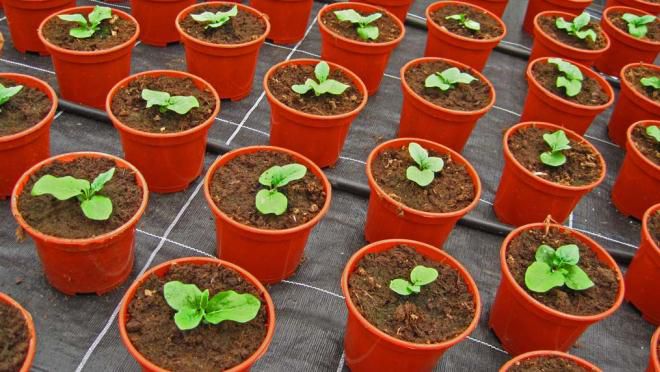
When young gerberas grow up, they must be planted in containers with a diameter of at least 15 - 20 cm. The flowering period, with proper care, begins in about 11 months.
Gerbera care at home
Illumination
When grown indoors, gerbera needs bright, diffused light.It is able to withstand a small amount of direct sunlight, but if the flower stands on the southern windowsill in summer, it must be shaded. It is not worth choosing windows with a north orientation, since there is very little light for the gerbera. In this regard, windows of an east or west orientation are best suited for a flower.
In summer, if desired, the bush can be rearranged outside, while at noon it must be protected from direct sunlight. And in order to avoid the appearance of sunburn on the foliage, it should be accustomed to new conditions gradually. In the autumn-winter period, it is recommended to illuminate the plant, for this it is best to use a fluorescent lamp.
Temperature regime
A gerbera growing in an apartment needs warmth, therefore, in the spring-summer period, the air temperature in the room should be about 24 degrees, while do not allow it to be colder than 20 degrees. At the end of flowering and during the dormant period, the bush should be cool (about 14 degrees). At this time, the air temperature should not be lower than 12 degrees. During flowering, the difference between day and night temperatures should not be very large, because this can have an extremely negative effect on the decorativeness of the inflorescences-baskets.
Watering
During the growing season, provide the flower with moderate watering, for this you need to use warm water. Make sure that the temperature of the substrate and water is practically the same, otherwise problems may begin with the flower. The water used for irrigation must be soft and well-settled; the substrate is carefully moistened only after its top layer has dried. Make sure that no liquid gets into the leaf outlet, as this can cause rot on the gerbera. During the dormant period, watering is carried out only so that the clod of earth in the pot does not dry out. At this time, stagnation of moisture in the root system is especially dangerous for the flower, because because of this it can get sick.
Moisturizing
For normal development and growth, the plant needs increased air humidity, but it is impossible to moisten its foliage from a spray bottle. To increase the humidity, wet expanded clay or peat must be poured into the pallet, and you can also moisten it from an air sprayer near the bush, but at the same time drops of water should not fall on the flower itself.
Bloom
Such a plant has one characteristic feature - its flowering directly depends on the length of daylight hours. Flowering is observed in late summer and early autumn, and at this time there is a decrease in daylight hours.
Fertilizer
Top dressing of gerberas should be carried out only during intensive growth, and for this, a complex mineral fertilizer is used for flowering indoor plants. The flower also responds well to feeding with magnesium sulfate. If it is in a cool place, then additionally it needs to be fed with phosphorus. In winter, feeding is not carried out.
Gerbera transplant
Gerbera is transplanted only when necessary, and this procedure is carried out in the spring. At the bottom of the pot, it is imperative to make a good drainage layer, while the acidity level of the soil mixture should be pH 5.0-6.0. During transplanting, make sure that the substrate does not get into the leaf outlet, and also remember that it cannot be buried in the soil mixture.
Seed growing rules
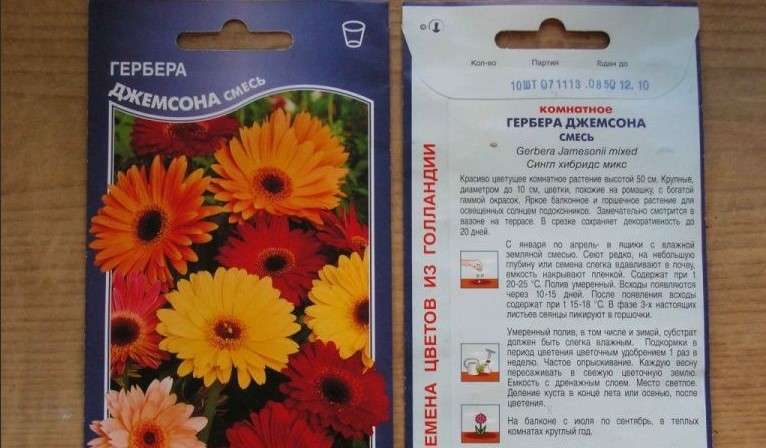
In order to grow a flower using seeds, you need to prepare a special soil composition. It is necessary to combine the following ingredients in equal amounts:
- garden soil;
- peat;
- perlite;
- sand.
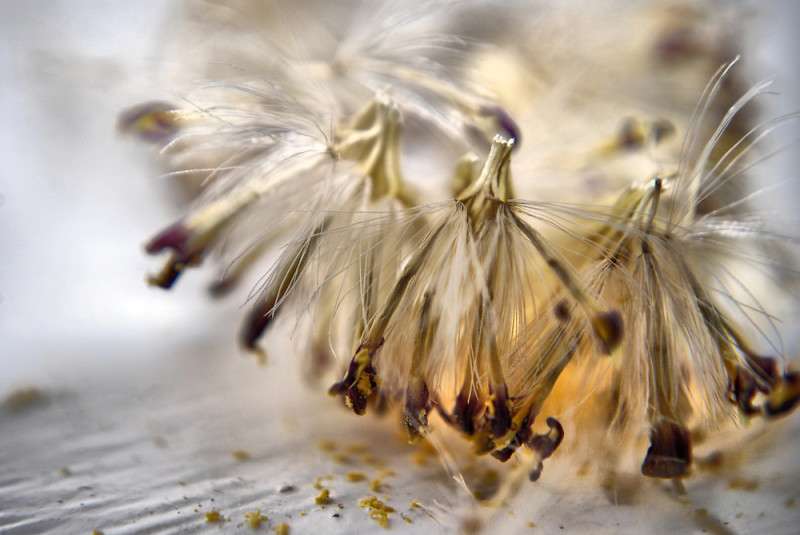
Next, you need to pour the finished mixture with a 20% solution of high temperature potassium permanganate in order to kill all harmful bacteria. It is most convenient to plant seeds in a spacious container with special holes. Expanded clay is more suitable for drainage, which will need to be covered with earth from above.
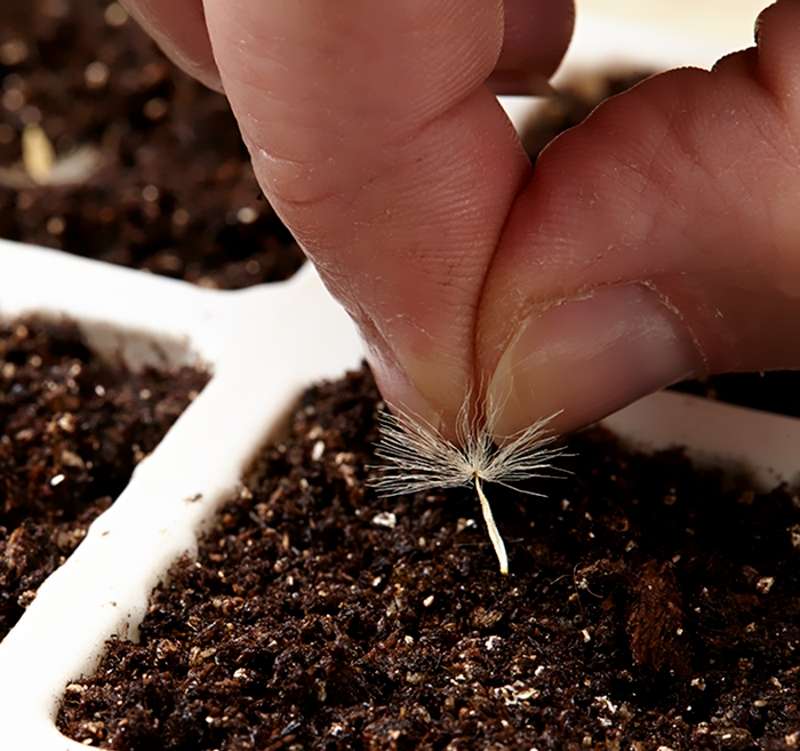
The seeds must be laid out on top, covered with a small amount of calcined sand. Cover containers in order to create a greenhouse effect. The room with seedlings should not be cold, and the lighting should be bright. It is more expedient to place containers with seedlings by a window facing west or east.

Then comes the time of active growth of the flower. For the first time, it is necessary to transplant a gerbera at a time when several full-fledged leaves have already grown. Shoots must be transplanted into a larger container, at a considerable distance from each other. When there are more than five leaves, the flowers should be transplanted into special, separate pots of medium diameter.
How to grow?
It is quite simple to grow a gerbera from seeds at home, it is enough to create the necessary conditions for it, observe the temperature, climatic regime, and do not forget to feed. This is a rather unpretentious plant, it does not require complicated care, it sprouts easily, and blooms beautifully. Even a novice florist can handle it.
Top dressing
You need to feed the gerbera at a time when it is gaining green mass, and during the flowering period. No fertilization is required during the dormant period.
The main thing is to remember that this plant does not tolerate humus and similar organic compounds.
Mineral compounds are best suited for feeding gerberas. At different periods of the life of a flower, these must be different substances.
So, when gaining green mass, the plant needs a complex fertilizer, which includes nitrogen. This element contributes to the correct formation of leaves, the full development of the plant.
When the gerbera begins to bloom, you need to change the type of feeding. During this period, it is better to apply potash fertilizers. Potassium accelerates metabolic processes in cells, helps the plant to endure drought more easily, accelerates photosynthesis, the plant adapts more easily to low temperatures.
Watering
Gerbera does not like abundant watering, but it also does not tolerate dry soil well. It is necessary to observe the "golden mean" and ensure that the soil is always moderately moist.
When watering, in no case should water get on the plant.
The best option would be a pallet. Then the plant itself will be able to take enough water when it needs it. It is also necessary to monitor the temperature of the water. It should be roomy, not very cold and not hot.
Climatic conditions
For gerbera, temperature and humidity levels are important. She feels comfortable at a temperature of +18.22 degrees, at higher or lower values she may start to hurt, wither, may stop blooming
In the cold season, when the plant is at rest, it needs to provide a temperature from +16 to +14 degrees, it can be slightly lower, but not less than +12.
As for humidity, there are also some nuances that must be observed. First of all, you need to remember that you should not spray gerbera from a spray bottle, it is better to spray water near the plant, without getting on the leaves. Another option is to place a container filled with water near the plant pot. The moisture will gradually evaporate and the flower will receive the moisture it needs.
Diseases and pests
If all the necessary conditions are met, gerbera is not prone to disease. But in case of violation of the temperature regime, improper watering or spraying, the plant may begin to rot, or powdery mildew will appear. It is easy to understand that something is wrong with the flower - its leaves will turn yellow or become covered with spots.
Powdery mildew is a white patch on the leaves that you can simply wipe off with your bare hands. If specks are visible on dying leaves, they are removed.
A remedy such as "Fitosporin" will help well in the fight against the disease - they are sprayed with a plant.
It is better to choose a liquid or pasty product to make it easier to dispense.
Gerbera pests include aphids, whiteflies, scale insects and mites.Methods of dealing with them are usual - you need to disinfect the soil, carefully examine the gerbera, remove unhealthy or damaged parts in time, and follow the rules of care.
Aphids can be fought with anabasine sulfate, nicotine sulfate, or the like.
To get rid of a spider mite, you need to wipe the leaves of the plant with soapy water (but then it must be washed off) or with an insecticide. After a week, repeat the treatment.
Whitefly is afraid of drugs that contain permethrin. The plant is sprayed with these compounds every 3 days until the pests disappear.
And you also need to know how and when to transplant a gerbera. Throughout the life of a plant, this should be done no more than 2-3 times. Each next container should be a couple of centimeters larger in diameter than the previous one, so that you can freely place the roots and pour fresh soil around them.

